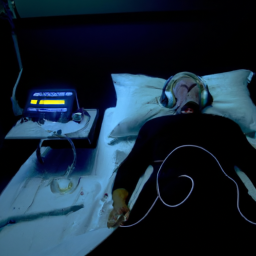Did you know that approximately 10-15% of the global population experiences tinnitus? And of those individuals, around 3-6% suffer from a specific type called pulsatile tinnitus.
If you’re one of them, you may be searching for answers and struggling to unravel the diagnosis. Look no further – this article will guide you through the world of ICD 10 codes for pulsatile tinnitus and help you understand the diagnostic process.
You’ll also discover various treatment options available to alleviate your symptoms and manage this condition effectively. Whether it’s medications, therapy, or lifestyle changes, there are solutions out there for you.
Additionally, we’ll explore how to cope with the daily challenges of pulsatile tinnitus and provide you with valuable support and resources.
Don’t let pulsatile tinnitus control your life – let’s untangle the diagnosis together.
Key Takeaways
- Pulsatile tinnitus is a rhythmic sound that matches the heartbeat and affects approximately 3-6% of individuals with tinnitus.
- ICD 10 codes help diagnose and classify pulsatile tinnitus, allowing for specificity in describing its characteristics such as unilateral or bilateral, intermittent or constant, and pulsatile or non-pulsatile.
- Accurate coding of pulsatile tinnitus is important for identifying underlying causes, formulating effective treatment plans, and monitoring progress.
- Treatment options for pulsatile tinnitus include medication, tinnitus therapy, and alternative treatments, and managing the condition requires a multi-faceted approach of medical interventions, therapy, and lifestyle changes.
Understanding Pulsatile Tinnitus
Pulsatile tinnitus is like a rhythmic drumbeat in your ears. It’s a condition where you hear a rhythmic sound that matches your heartbeat. Unlike regular tinnitus, which is a constant ringing or buzzing, pulsatile tinnitus has a pulsing or throbbing quality.
The causes of pulsatile tinnitus can vary, but some common factors include high blood pressure, an abnormality in the blood vessels, or muscle contractions in the ear. Symptoms of pulsatile tinnitus can include hearing the pulsing sound in one or both ears, changes in sound intensity with body position, and sometimes even a visible pulsation in the ear.
Understanding the causes and symptoms of pulsatile tinnitus is important for proper diagnosis and treatment. Now, let’s explore the icd 10 codes for pulsatile tinnitus.
Exploring the ICD 10 Codes for Pulsatile Tinnitus
Discover the vast array of codes available in the ICD 10 system that can help you pinpoint the underlying cause of your rhythmic and pulsating ear sounds. When it comes to icd 10 coding for pulsatile tinnitus, medical documentation plays a crucial role in accurately diagnosing the condition.
Here are four important aspects to consider:
-
Specificity: The ICD 10 codes offer a wide range of options to describe the characteristics of your tinnitus, such as unilateral or bilateral, intermittent or constant, and pulsatile or non-pulsatile.
-
Underlying cause: These codes allow you to identify potential factors contributing to your tinnitus, such as vascular issues, middle ear abnormalities, or even medication side effects.
-
Associated symptoms: Documenting any additional symptoms, such as dizziness or hearing loss, can help in determining the appropriate code and understanding the overall condition.
-
Treatment considerations: Accurate coding also helps in formulating effective treatment plans and monitoring the progress of your pulsatile tinnitus.
Understanding the importance of icd 10 coding and medical documentation sets the foundation for the diagnostic process for pulsatile tinnitus.
The Diagnostic Process for Pulsatile Tinnitus
When you experience rhythmic and pulsating sounds in your ears, the diagnostic process for identifying the underlying cause can provide valuable insights into your condition and guide your treatment options.
To begin the diagnostic journey, your healthcare provider will conduct a thorough examination, including a detailed medical history and physical examination. They may also order specific diagnostic tests, such as a hearing test, imaging studies (like an MRI or CT scan), or blood tests to rule out any underlying medical conditions or abnormalities. These tests can help pinpoint the potential causes of your pulsatile tinnitus, such as blood vessel disorders, middle ear abnormalities, or tumors.
By identifying the underlying cause, your healthcare provider can then recommend appropriate treatment options to alleviate or manage your symptoms effectively.
Now, let’s delve into the next section, where we will explore the various treatment options available for pulsatile tinnitus.
Treatment Options for Pulsatile Tinnitus
There are various treatment options available for managing pulsatile tinnitus, and a study found that approximately 70% of patients experienced significant improvement in their symptoms with the use of medication.
Tinnitus therapy is commonly used to alleviate the symptoms of pulsatile tinnitus. This therapy includes techniques such as cognitive behavioral therapy, sound therapy, and tinnitus retraining therapy. Cognitive behavioral therapy helps patients change their negative thoughts and emotions associated with tinnitus, while sound therapy uses external sounds to mask or distract from the tinnitus sounds. Tinnitus retraining therapy aims to retrain the brain to filter out the tinnitus sounds.
In addition to these conventional treatments, alternative treatments such as acupuncture, herbal supplements, and relaxation techniques have also been explored. These alternative treatments may provide relief for some individuals with pulsatile tinnitus.
Managing the symptoms of pulsatile tinnitus requires a multi-faceted approach that combines medical interventions, therapy, and lifestyle changes.
Managing the Symptoms of Pulsatile Tinnitus
To effectively manage the symptoms of pulsatile tinnitus, you can explore a combination of medical interventions, therapy, and lifestyle changes. Managing strategies for pulsatile tinnitus involve finding ways to reduce the intensity and frequency of the pulsing sounds in your ears. One approach is to use sound therapy, which involves playing soothing sounds or music to mask the tinnitus sounds and provide relief. Another option is cognitive behavioral therapy, which can help you develop coping mechanisms and reduce the emotional distress caused by pulsatile tinnitus. Additionally, adopting certain lifestyle modifications can make a significant difference. These may include reducing stress levels, practicing relaxation techniques, maintaining a healthy diet, avoiding loud noises, and getting regular exercise. By implementing these strategies, you can take control of your symptoms and improve your quality of life. As you continue your journey towards managing pulsatile tinnitus, it is essential to seek support and access available resources to further enhance your well-being.
Next, we will discuss the various support and resources for individuals with pulsatile tinnitus.
Support and Resources for Individuals with Pulsatile Tinnitus
Support and resources are like a guiding light for individuals with pulsatile tinnitus, offering comfort and assistance on their journey towards managing their symptoms.
If you’re struggling with pulsatile tinnitus, there are online communities where you can connect with others who understand what you’re going through. These communities provide a safe space to share experiences, ask questions, and find support from people who can relate to your struggles.
Additionally, there are coping strategies available that can help you better manage your symptoms. These strategies may include relaxation techniques, mindfulness exercises, and sound therapy. By incorporating these coping strategies into your daily routine, you may find relief from the distressing symptoms of pulsatile tinnitus.
Remember, you’re not alone in this journey, and there are resources available to help you every step of the way.
Frequently Asked Questions
What are the main causes of pulsatile tinnitus?
The main causes of pulsatile tinnitus include abnormalities in blood vessels, such as atherosclerosis or arteriovenous malformations, which can lead to turbulent blood flow.
Other factors may include certain medical conditions like high blood pressure, thyroid disorders, or anemia.
Natural remedies for pulsatile tinnitus can include managing stress, avoiding loud noises, maintaining a healthy lifestyle with regular exercise and a balanced diet, and practicing relaxation techniques like yoga or meditation.
Are there any natural remedies or alternative treatments for pulsatile tinnitus?
Looking for natural remedies or alternative treatments for pulsatile tinnitus? While medical interventions are often necessary, there are some options you can explore.
Many people find relief through relaxation techniques like yoga or meditation, which can help manage stress and reduce symptoms.
Additionally, certain dietary changes, such as reducing caffeine and salt intake, may also provide some relief.
Remember, it’s always important to consult with a healthcare professional before trying any alternative treatments.
Can pulsatile tinnitus be a symptom of a more serious underlying condition?
Pulsatile tinnitus can indeed be a symptom of a more serious underlying condition. Understanding pulsatile tinnitus causes is crucial for early detection and treatment.
Some serious conditions that can cause pulsatile tinnitus include high blood pressure, carotid artery disease, and abnormal blood vessels.
If you experience pulsatile tinnitus, it’s important to consult a healthcare professional for a proper diagnosis and appropriate treatment. Don’t ignore this symptom as it may indicate an underlying health issue.
How long does it usually take to accurately diagnose pulsatile tinnitus?
How long does it usually take to accurately diagnose pulsatile tinnitus? Can doctors quickly determine the cause of this condition?
Well, accurate diagnosis time can vary due to the diagnostic challenges involved. Identifying the underlying cause of pulsatile tinnitus requires a thorough evaluation, including medical history, physical examination, and possibly imaging tests.
The process may take several weeks or even months, as doctors strive to pinpoint the exact cause and provide you with the most effective treatment options.
Are there any specific lifestyle changes or habits that can help alleviate the symptoms of pulsatile tinnitus?
To alleviate the symptoms of pulsatile tinnitus, there are several lifestyle changes and habits you can try. First, consider reducing your intake of caffeine and alcohol, as they can worsen symptoms.
Regular exercise and stress management techniques, such as deep breathing or meditation, may also help.
Additionally, maintaining a healthy diet and getting enough sleep can contribute to overall well-being and potentially improve your symptoms.
Remember, it’s important to consult with a healthcare professional for personalized advice.
Conclusion
In conclusion, navigating the world of pulsatile tinnitus can be overwhelming, but with the right information and resources, you can take control of your condition.
Remember, knowledge is power, so stay informed about the ICD 10 codes and diagnostic process.
Explore the various treatment options available and find what works best for you.
Don’t forget to manage the symptoms with self-care techniques and seek support from others who understand your journey.
Keep pushing forward, because with time and effort, you can find relief and live a fulfilling life despite pulsatile tinnitus.




